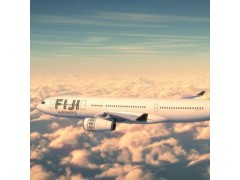


Search
|
Home » Welcome

On 1st September 1951, a 7-seater De Havilland Dragon Rapide took off from the Fiji’s Nausori Airport to Drasa Airport near Lautoka, on the west coast of the main island. This first commercial flight saw the birth of what today is a truly international, Fijian airline. Together with its domestic/regional subsidiary of Pacific Sun, Fiji Airways flies over 400 flights a week to almost 15 cities in 10 countries around the world. Taking on various challenges that no airline in the global airline industry is immune from, Fiji Airways has passed various tests with flying colours, more than ably fulfilling its dual roles of flying Fiji and contributing significantly to its economy.
Harold George Gatty
Harold George Gatty was born to British parents in Campelltown in Tasmania on 5 January 1903 and came to settle in Fiji after World War II. He was no stranger to the island nation, as he was based in Auckland before the war as Australasia’s representative of Pan American World Airways. He joined the US Army Air Force during the war, serving first in Java before relocating to Brisbane at General Douglas McArthur’s headquarters and New Guinea after that. He returned to his Pan American job in Auckland at the end of the war and moved to settle in Fiji a few years later. Here he bought an island in Fiji’s eastern island group called Katafaga and turned it into a coconut estate. Before his Pan American job, Gatty had made his name in air navigation in the United States. Using his good sea navigation skills acquired as a cadet midshipman trainee at the Australian Naval College, Gatty invented a navigation system for pilots.
In conjunction with the so called ‘Weems Curves’,Gatty devised his revolutionary ground speed and drift indicator. This allowed for navigation by dead reckoning and did away with the need to take shots from the sun or stars, and it was the forerunner of the automatic pilot, now standard equipment on virtually all commercial and military aircraft.
1959
Gatty got to use his own invention that shot him to international fame when Canadian pilot Lieutenant Harold Bromley invited him to be his navigator in his attempt to fly across the Pacific from Honshu, Japan, to Tacoma in Washington State, USA in September 1930. Fuel tank problem forced the plane back to Honshu after 1,900km of flying, and it is said that despite heavy fogs, Gatty navigated the plane by dead reckoning back to their starting point.
Again he followed this up in 1931 when Wiley Post, a native American oil rigger and stuntman flew around the world in eight days. Gatty was his navigator and that feat earned the two aviators a ticker-tape welcome in New York City. As a British citizen, the US Congress awarded him the Distinguished Flying Cross. It was said that despite the accolades, Gatty declined the offer to become an American citizen. His appointment not long thereafter as Pan American World Airways representative based in Auckland brought him to the Pacific, and to Fiji.
Gatty submitted a proposal to Fiji’s then Colonial Government to operate the country’s domestic airline and registered it as Katafaga Estates. The first commercial flight was one September 1st, 1951. While Gatty died on August 30th1958, his bold and visionary initiative had taken off to greater heights, and today has etched its place in Fiji’s aviation history.
1965
The Past
During the eventful 60-years, Air Pacific was also about an attempt at regionalism that almost succeeded. By the early 1970s, up to seven island governments of the Pacific, some of them still under British colonial rule then, held shares in Air Pacific. This was in addition to shares held by QANTAS, New Zealand’s TEAL and the British Overseas Airways Corporation, forerunners of Air New Zealand and British Airways respectively. But the regional airline idea fizzled as other Government’s bailed out, leaving Fiji as the majority shareholders in the airline.
For a small airline, Fiji Airways has always been punching way above its weight. Early in the 1980s, it pioneered the code-share concept with Qantas. Today, code-sharing is an accepted airline practice the world over. 25 January 1995 was another watershed date for Fiji’s airline when it launched what was believed to be a trail blazing concept of joint leasing of aircraft with the then Royal Tongan Airline. The concept came complete with the livery of the two airlines painted on each half of the Boeing 737-300 fuselage.
Giving thanks wher it’s due
There’s general consensus that a long list of men and women helped Fiji’s international airline get to wher it is today. From the pioneers and visionaries brave enough to operate an airline out of the middle of the Pacific during its early years to the hundreds of dedicated and committed Fijians working hard to make it the world’s friendliest airline; words cannot do justice to describe the gratitude of the company. Several years ago, long serving former chairman of the airline, retired business executive Gerald Barrack paid tribute to Gatty’s vision and the pioneering spirit of men and women like him “from the days when pilots flew Dragon Rapides and Drovers by the seat of their pants.” Days like the one wher passengers boarded the Rapides plane and realized that there was no pilot, so a man wearing a bright bula (floral) shirt volunteered to fly the machine. Little did they realize that the man with the bright shirt was actually Fred Ladd, Gatty’s first Chief Pilot, playing his usual practical jokes!
1971
Invited for his observations as "Air Pacific" celebrated its 60th anniversary, past CEO John Campbell said the men and women who built the airline are a source of great pride. “It is not easy to operate a reliable airline with a wide spread network from a small country in the middle of the Pacific. There are logistical, training, spare parts inventory and skill retention and development issues that an airline based in a major market does not face. That the airline has been able to overcome these barriers is a credit to its people and a testament to their commitment and frequent personal sacrifice.
“Fiji citizens can take pride in the overall success of their airline, which truly is the critical link between Fiji and the world and has been and hopefully will continue to be fully committed to serving Fiji's aviation needs. I believe this is what was hoped for by Harold Gatty when establishing the airline.” As it celebrates its 60th birthday, the Managing Director & CEO at the time, Dave Pflieger, joined his predecessor in praising Harold Gatty’s vision and the people of Fiji for making Air Pacific a world-class international airline.
“Air Pacific’s greatest asset is its people – from our maintenance and ground crews, to the pilots and flight attendants, to our schedulers and administrative staff,” Mr. Pflieger told Fiji Islands magazine. "The many changes and the improvements they are making now will serve Fiji and Fijians well for another 60 years. They are rising to the challenge of new competition and an ever changing world, and creating a strong legacy. It is an honour to work with everyone here."
The Present
For an airline that was started by an acclaimed air navigator, inventor, airline manager, plantation baron and legislator, Fiji Airways has grown into Fiji’s proud flag carrier. From flying De Havilland Dragon Rapide in those days to the new Airbus 330-200 jets of today, the airline has truly come of age. It boasts a strong position within the region, and is often ranked among the region’s top carriers.
2013
In May 2012, the airline announced that it would reintroduce the name Fiji Airways to reinforce its role as the proud national airline of Fiji. Offering its customers brand new Airbus A330-200 aircraft and warm friendly Fijian service, Fiji Airways connects the islands of Fiji to the world and proudly welcomes visitors to its home. As our airline proudly returned to its roots as Fiji Airways, we embarked on a new and exciting chapter of our story.
|

